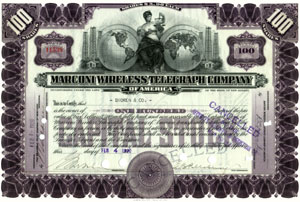Station X
by G. McLeod Winsor
H. Jenkins: London, 1919
Lippincott: Philadelphia and London
Station X, by G. McLeod Winsor, is a window into the past. First published in London in 1919, it stands in between two of the fictional traditions ancestral to science fiction: the future war novels and scientific romances of the Victorian and Edwardian eras, and the pulp adventure novels of the years between World Wars I and II. The technology it describes is also transitional.
 It's easy for us to forget, now that radio and television and wireless data transmission are all around us, that radio waves were ever unfamiliar and mysterious. But only a century ago, they were a new and scarcely understood discovery. The literature of the period links them to psychic phenomena, as in Kipling's story "Wireless", where a drugstore clerk's amateur radio set puts him into telepathic rapport with the mind of John Keats, across a gap of decades. T. S. Eliot's "The Waste Land", with voices fading in and out like radio channels as the mind of the blind seer Tiresias drifts across London, suggests the same kind of equation. Winsor carries the idea farther, with interplanetary radio communication providing a channel for telepathic invasion.
It's easy for us to forget, now that radio and television and wireless data transmission are all around us, that radio waves were ever unfamiliar and mysterious. But only a century ago, they were a new and scarcely understood discovery. The literature of the period links them to psychic phenomena, as in Kipling's story "Wireless", where a drugstore clerk's amateur radio set puts him into telepathic rapport with the mind of John Keats, across a gap of decades. T. S. Eliot's "The Waste Land", with voices fading in and out like radio channels as the mind of the blind seer Tiresias drifts across London, suggests the same kind of equation. Winsor carries the idea farther, with interplanetary radio communication providing a channel for telepathic invasion.
The first users of radio included ships, which were large enough to support the massive apparatus then needed to transmit and receive radio signals. It was a triumph of miniaturization when armies of World War I could make a set small enough for a horse-drawn wagon. And radio was just what naval fleets needed. After the Russo-Japanese War in 1905, naval engagements were fought not at less than a mile but at five or ten miles; radio greatly improved the ability of fleets to pursue coordinated tactics and strategy.
It also meant that orders could reach a fleet out at sea; the Starfleet captains of Star Trek and its successors, constantly exchanging subspace messages with headquarters, are very much in a 20th Century naval tradition, vastly different from earlier centuries when captains had to operate on their own judgment, unable to send home for orders. Winsor envisions the British fleet responding to this technological imperative by building a wireless relay station in the central Pacific, able to detect signals from British Columbia and relay them to Australia, or the reverse. And that's where the trouble begins, as its extremely sensitive circuits and its highly skilled operator pick up messages from much farther away.
From this point on the plot becomes melodramatic, with heroic scientists and sea captains making decisions that shape the fate of humanity. The characters are equally melodramatic, without complex motivation. But the fears the author evokes to drive his story are curiously subtle, with information itself being a means of assault on humanity. Winsor is envisioning information and communication as key factors in military conflict, an idea that our hindsight makes far more inevitable than it was when this book was written.
Station X is more interesting as a historical document than as fiction; but it's readable enough to be worth a look for historians of science fiction.
DLF facilitated this.
Marconi's Wellfleet (Cape Cod) Wireless Station,
early Twentieth Century
More by William H. Stoddard
| Troynovant, or Renewing Troy: | New | Contents | |||
| recurrent inspiration | Recent Updates | |||
|
www.Troynovant.com |
||||
|
Reviews |
||||
| Strata | Regions | Personae |
|
|||